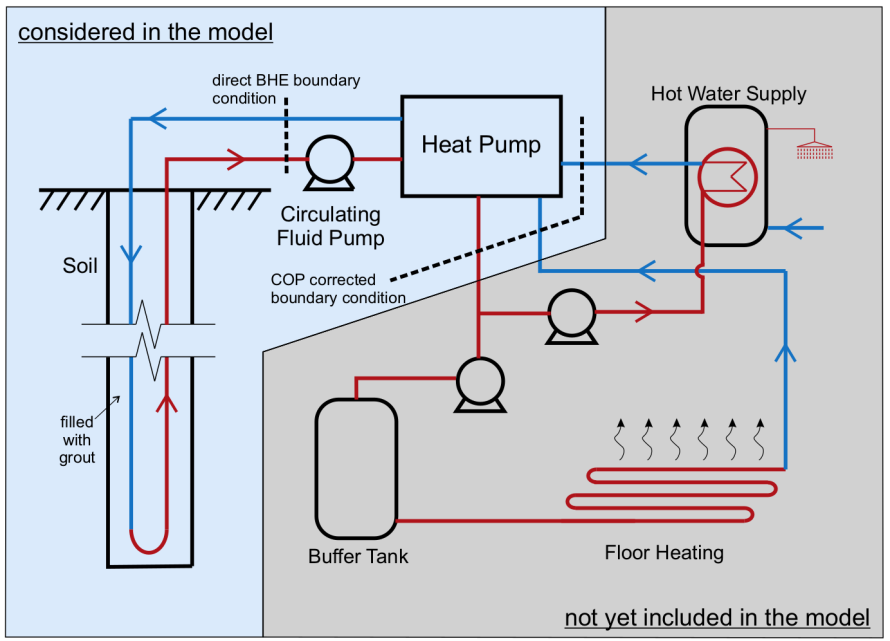EASyQuart-Plus
 Schematic representation of a model for the operation of a borehole heat exchanger, coupled with a heat pump system for thermal building supply (Fig. From Zheng et al., 2016)
Schematic representation of a model for the operation of a borehole heat exchanger, coupled with a heat pump system for thermal building supply (Fig. From Zheng et al., 2016)
Project title: Energieeffiziente Auslegung und Planung dezentraler Versorgungsnetze zum geothermischen Heizen und Kühlen von Stadtquartieren – Digitalisierung und Praxiswirksamkeit
(Project title – English translation: Energy-efficient design and planning of decentralised supply networks for geothermal heating and cooling of urban areas – digitization and practical effectiveness)
Project description:
The shallow subsurface offers a base load capable thermal potential for the urban heat energy supply. In Germany, this potential is usually exploited using heat pumps. As a result, the optimised operation of ground-based heat pump systems is crucial for low primary energy consumption and the economically and ecologically sustainable use of geothermal resources.
Extensive experience and a wide range of literature are available for the optimisation of individual borehole heat exchanger systems (BHE). The current design practice for large-scale BHEs is based primarily on the same documents (guidelines, directives, etc.) and regulatory framework conditions that were created for the planning of individual systems. Thus, neighbourhood solutions are required that allow both optimised system dimensioning and efficient as well as sustainable operation of the systems.
The overall goal of the project is the practical upgrading and implementation of concepts, workflows and instruments of a decision support system for heating and cooling of buildings and districts using shallow geothermal resources. Methodical preparatory work for components of the system and their validation were carried out within the framework of EASyQuart. Here, the decision-making aids are to be formed from recommendations for action to a holistic set of digital tools. This is based on workflows, algorithms, interfaces and software components that are used in an early phase of planning building and district projects for feasibility studies and also in the actual dimensioning process. With the implementation of project results as part of the digital twin of a real system, the practical usability of the decision-making aids under real conditions on the site scale is proven. In addition, in-depth methodological analyzes are carried out in order to close existing gaps in knowledge. Topics such as the improved strategic communication of geothermal content in different target groups and the integration of geothermal energy in holistic energy system analyzes and in the supply of existing buildings are newly included. With the concepts and instruments developed as exemplary solutions and with extended recommendations for making regulatory framework conditions more flexible, standards for the planning industry are revised and suggested for their safe implementation in practice.
The sub-project introduces innovative methods for geophysical exploration and monitoring in the subsoil, subsoil simulation and for the integrated 3D visualization of heterogeneous data as scientific components in the digital planning tools, the decision-making aids and the communication formats. Analyses at demonstration sites are used to parameterise simulation models and to evaluate individual project results. The innovation of the project idea consists in the development and practical application of instruments for the site-based analysis of the supply and demand side, including their validation with site data, and offers commercial users and public authorities support in the prediction of the economic efficiency of usage options of the shallow subsurface for heating and cooling from individual buildings to urban areas.
